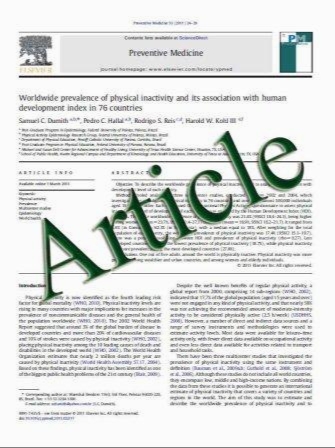Psychological distress and C-reactive protein: do health behaviours and pathophysiological factors modify the association?
- نوع فایل : کتاب
- زبان : انگلیسی
- مؤلف : Pekka Johannes Puustinen Hannu Koponen Hannu Kautiainen Pekka Ma¨ntyselka¨ Mauno Vanhala
- چاپ و سال / کشور: 2011
Description
The objective of this study is to examine the association of psychological distress to high-sensitivity C-reactive protein (hsCRP) levels and to examine the potential mediating role of health behaviours and pathophysiological factors. A total of 883 (393 men and 490 women) subjects, aged 36–56 years, participated in a population-based, cross-sectional study from 1997 to 1998 in Pieksa¨ma¨ki, Finland. Various clinical, biochemical and behavioural factors were measured, including hsCRP concentration. Psychological distress was measured using the 12-item General Health Questionnaire (GHQ-12). Subjects with low psychological distress (0 points in GHQ-12) were younger and more physically active, and their mean hsCRP level was lower when compared to subjects with medium (1–3 points) or high (4–12 points) psychological distress (1.26 ± 1.36, 1.53 ± 1.75 and 1.70 ± 1.68 mg/l, respectively, P for linearity = 0.003). Psychological distress was also associated with high relative cardiovascular risk (hsCRP[3.00 mg/l). After adjusting for gender, age, BMI, smoking, use of alcohol and leisure time physical activity, odds ratios for hsCRP[3.00 mg/l in the groups that had medium and high psychological distress were 1.32 (95% CI: 0.81–2.16) and 1.79 (95% CI: 1.05–3.04), respectively, compared with the low distress group (P for linearity 0.032). Psychological distress was associated with elevated hsCRP levels representing high relative cardiovascular risk. This association remained after adjusting for health behaviours and pathophysiological factors, supporting a direct, physiological link between psychological distress and inflammation. CRP could be an important pathophysiological mechanism through which psychological factors are associated with cardiovascular disease
Eur Arch Psychiatry Clin Neurosci (2011) 261:277–284 DOI 10.1007/s00406-010-0134-x, Received: 18 June 2009 / Accepted: 3 August 2010 / Published online: 14 August 2010


